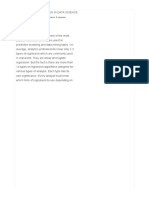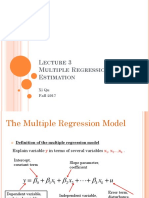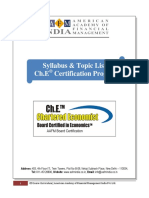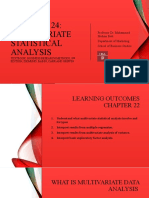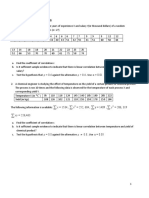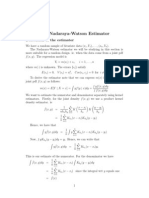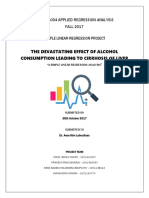Regression is a statistical technique used to model the relationship between one or more
independent variables (predictors) and a dependent variable (response). The goal of regression
analysis is to understand the nature of this relationship and to make predictions or inferences about
the dependent variable based on the values of the independent variables.
Types of Regression:
1. Linear Regression: This is the simplest form of regression, where the relationship between
the independent variable(s) and the dependent variable is modeled as a straight line.
o Simple Linear Regression: Involves one independent variable (X) and one dependent
variable (Y). The model is typically written as: Y=β0+β1X+ϵY = \beta_0 + \beta_1X + \
epsilon where:
YY is the dependent variable,
XX is the independent variable,
β0\beta_0 is the intercept (constant),
β1\beta_1 is the slope (coefficient), and
ϵ\epsilon is the error term.
o Multiple Linear Regression: Involves two or more independent variables. The model
is extended to include multiple predictors: Y=β0+β1X1+β2X2+⋯+βnXn+ϵY = \beta_0
+ \beta_1X_1 + \beta_2X_2 + \dots + \beta_nX_n + \epsilon where X1,X2,...,XnX_1,
X_2, ..., X_n are the independent variables.
2. Logistic Regression: Used when the dependent variable is categorical, typically for binary
outcomes (e.g., success/failure, yes/no). It predicts the probability of an event occurring
based on one or more predictors. The model uses the logistic function to constrain the
predicted values to be between 0 and 1:
P(Y=1∣X)=11+e−(β0+β1X)P(Y = 1 | X) = \frac{1}{1 + e^{-(\beta_0 + \beta_1X)}}
where P(Y=1∣X)P(Y = 1 | X) is the probability of the event occurring (e.g., success), and ee is the base
of the natural logarithm.
3. Polynomial Regression: This is an extension of linear regression that models the relationship
between the independent variable and the dependent variable as an nth-degree polynomial.
This allows for modeling non-linear relationships.
4. Ridge and Lasso Regression: These are forms of regularized regression that add a penalty to
the regression model to avoid overfitting. Ridge regression adds the squared magnitude of
coefficients (L2 regularization), while Lasso regression adds the absolute magnitude of
coefficients (L1 regularization).
5. Non-Linear Regression: When the relationship between the dependent and independent
variables is not linear, non-linear regression models are used to fit more complex curves.
Key Concepts in Regression:
Intercept (β₀): The value of the dependent variable when all the independent variables are
zero.
� Slope (β₁, β₂, ..., βn): The amount by which the dependent variable changes for a one-unit
change in the independent variable.
Residuals: The differences between the observed values and the values predicted by the
regression model. Residuals help assess the goodness of fit.
R-squared (R²): A statistical measure that represents the proportion of the variance in the
dependent variable that is predictable from the independent variables. An R² value closer to
1 indicates a better fit of the model.
How Regression Works:
1. Model Fitting: The regression algorithm finds the best-fitting line (or curve) that minimizes
the difference between the predicted values and the actual data points. This is typically done
using methods like Ordinary Least Squares (OLS), which minimizes the sum of squared
residuals.
2. Prediction: Once the model is trained, it can be used to predict the dependent variable for
new values of the independent variables.
Applications of Regression:
Predictive Analytics: Predicting future values based on historical data (e.g., predicting sales,
stock prices, or temperature).
Risk Assessment: In finance or healthcare, regression models are used to predict outcomes
like credit scores or disease risk based on various factors.
Econometrics: Modeling economic relationships (e.g., how factors like income, education,
and age influence spending).
Quality Control: Understanding how different factors (e.g., temperature, pressure) affect a
manufacturing process.
Marketing: Identifying how various marketing strategies influence consumer behavior and
sales.
Example:
In a simple linear regression, you might want to predict a student's exam score (Y) based on the
number of hours they studied (X). After fitting a regression model, you might find an equation like:
Y=50+10XY = 50 + 10X
This means that for each additional hour of study, the exam score increases by 10 points. If a student
studied for 3 hours, their predicted exam score would be:
Y=50+10(3)=80Y = 50 + 10(3) = 80
In this case, the model provides an easy way to predict outcomes based on the given input (hours
studied).
Regression is a fundamental technique used in various fields, including data science, economics,
engineering, and social sciences, to understand relationships between variables and make
predictions.














































